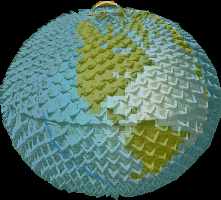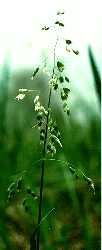 |
This modern Pima-Maricopa (Tohono O'odham) girl steps out of the past -- a Maricopa woman photographed around 1900 with a head-carry basket, in front of a big cactus, whose fruits she was harvesting. The modern girl's basket is made in the old way. She balances it as gracefully as her ancestresses. But the modern girl appears in an ad for the Salt River Pima-Maricopa Tribe's tourist museum and craft shop. Her basket's a prop, not a survival tool. |
|---|---|
|
Basketmaking is the traditional Native art-craft that has the most difficult problems of survival. Unlike beadwork, clothing or jewelry, baskets traditionally were not luxuries of dress and decoration, but tools of living. Lightweight, portable, sturdy containers for gathering, harvesting, storage, cooking, and serving food. The land-takings, the changes in all lifeways -- and the availability of cheap mass-produced kitchen and storage ware -- has meant that the only remaining use-function of baskets in Indian communities is a few ceremonial uses, and occasional home display or gifts. Purchasers of today's baskets are mostly non-Indian tourists (for souvenir cheap ones) and well-off non-Indian collectors or museums (elaborate, expensive time-consuming art baskets). Basketry has economic value for successful basketmakers and the value of cultural pride and heritage, but unlike beadwork, jewelry, clothing, textiles -- from small items worn every day to large powwow outfits -- the market, the people most baskets are made to sell to, is not their Native community. Baskets are made for show, not use. Beyond the problem of community is an even greater one. Environmental change is the biggest problem confronting those basketmakers who are motivated by cultural pride to keep the tradition going. They need to gather the plant materials at the right times of year, and prepare them in the traditional manner, using the natural materials for pattern and dye. The natural materials -- especially for southwestern and California baskets -- require long-distance travel to where the plants grow to dig roots, cut shoots, branches, canes, seed pods. It takes as long or longer to gather and prepare materials for a traditional basket as to make it. Sometimes no access is allowed to land where these plants still grow. To be a traditional basketmaker requires not only many years of apprenticeship learning the technical skills, but learning from older women where the plants grow, how to identify them, what parts to take when, and how to prepare them, Traditional basketmakers must be in close touch with the earth, the seasons, and the growth habits of plants that are considered either undesirable weeds, or of no importance to modern civilization. Many of the places where these plants once grew untended, gifts of the Creator, are now plowed under, built over, or a few stands survive on private or government land where Indian women are not allowed to dig roots or gather branches or pods. But the biggest threat is that urban amd iindustrial pollution menaces the survival of just about all the traditional plants used in the basketmakers' arts. |
|
 |
Fraxinus niger is the scientific name for Black Ash. Its Ojibwe name is aagimaak. There are also white (baapaagimaak) and brown ash species. Ash is used by northern Native wood-splint basket weavers. Edith Bonde's wonderful baskets are all made of it. Mohawk and other 6 Nations basketmakers have long used it not only for ornamental baskets, but for weaving the lightweight, practical backpacks many hikers use, long a popular item sold by Native craftspeople from upstate New York and New England. |
|
Ash trees began to die -- and within a decade the trees were almost all dead -- at Akwesasne-St. Regis (a New York Mohawk reservation which spans the U.S. - Canada border) and other upstate 6 Nations reservations with the opening of the St. Lawrence Seaway, and heavy industry that immediately began to grow along the river bcause of cheap hydro power and shipping access. This pollution has been life-threatening to people and animals of the region, for mor than 20 years,something that has received more attention than the effects on plants of acid rain, poly-chlorinated biphyenyls (PCB's) and other industrial chemicals that contaminate air, water, rain, and snow (hence local lakes and streams and groundwater). Akwesasne is th most polluted rserve in Canada, and one of the most toxic spots in the U.S. It is no longer safe to eat fish or garden produce, the main subsistence of Native people from this area until the early 1970's. Twenty years ago, most ash trees wer gone from upstate New York (and Canada across the river). Mohawk basketmakers had to travel to Maine forests to get black ash for basket splints. Now those trees are dying off too, as pollution from the northwest west along the St. Lawrence contaminates the remaining New England and Canadian Maritime provinces forests For a current exhibit, Hudson Museum -- Trees and Tradition: Baskets,, elder Maliseet, Micmac, Passamaquoddy, and Penobscot basketmakers discuss both their tradition and the dying off of brown ash, "the basket tree" in their languages, due to dieback in the late 1980's. The museum quotes various experts, claiming it's a natural process. But it seems far more likely this is the arrival east of the industrial pollution effects felt two decades earlier in their locality by the Mohawk basketmakers further west. Ten years after that, pollution was killing animals, people, and garden produce was no longer safe to eat. The experts quoted here are just helping in a coverup of what the real causes are. | |


